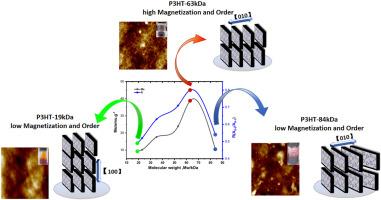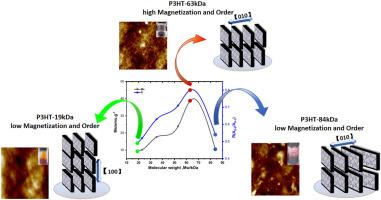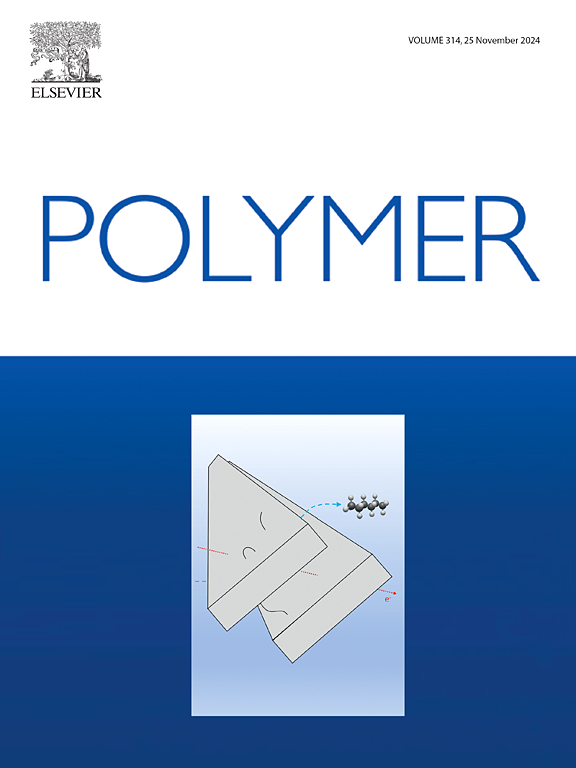聚(3-己基噻吩)在室温下的铁磁性与分子量有关
IF 4.1
2区 化学
Q2 POLYMER SCIENCE
引用次数: 0
摘要
聚(3-己基噻吩)(P3HT)具有丰富的自旋特性和优异的溶液加工能力,是一种前景广阔的有机磁性材料。然而,其磁性能与其电子结构和薄膜固态有序性的依存关系尚不清楚。本文通过对分子量在 19 至 84 kDa 之间的 P3HT 进行对比研究,探讨了分子量(Mw)对 P3HT 薄膜室温铁磁性的影响。研究仔细排除了磁性杂质的干扰。通过结构分析,研究了不同 Mw 的 P3HT 薄膜的聚集形态和分子特征。观察到 P3HT 薄膜铁磁性的差异,并将其归因于混合溶剂中固态秩序的变化。饱和磁化(Ms)随着 Mw 的增大先增大后减小,在 63 kDa 时达到最大值 38.8 emu g-1,这是由于 P3HT-63 kDa 薄膜的分子链顺序和结晶度最大。P3HT-84 kDa 薄膜的无序结构成分比例较高,共轭长度有限,因此结晶度和磁性较低(10.5 emu g-1)。本文章由计算机程序翻译,如有差异,请以英文原文为准。


Molecular-weight dependence of ferromagnetism at room temperature of poly (3-hexylthiophene)
Poly (3-hexylthiophene) (P3HT) is one of the promising organic magnetic materials due to its abundant spin properties and excellent solution processing ability. However, the dependence relationship of its magnetic properties on its electronic structure and solid-state order in thin film is unclear. Herein, the effect of molecular weight (Mw) on the ferromagnetism at room temperature of P3HT films was investigated by a comparative study on P3HT with Mw ranging from 19 to 84 kDa. The interference of magnetic impurities was carefully excluded. Structural analyses were performed to investigate the aggregates morphology and molecular features of P3HT thin films with different Mw. Differences in P3HT film ferromagnetism were observed and attributed to variation of solid-state order in mixed solvent. The saturation magnetization (Ms) increases first and then decreases with the increase of Mw, reaching a maximum value of 38.8 emu g−1 at 63 kDa, which was due to the largest molecular chain order and crystallinity of P3HT-63 kDa films. P3HT-84 kDa films had a higher proportion of disordered structural components and limited conjugation length, and yielding low crystallinity and magnetism (10.5 emu g−1).
求助全文
通过发布文献求助,成功后即可免费获取论文全文。
去求助
来源期刊

Polymer
化学-高分子科学
CiteScore
7.90
自引率
8.70%
发文量
959
审稿时长
32 days
期刊介绍:
Polymer is an interdisciplinary journal dedicated to publishing innovative and significant advances in Polymer Physics, Chemistry and Technology. We welcome submissions on polymer hybrids, nanocomposites, characterisation and self-assembly. Polymer also publishes work on the technological application of polymers in energy and optoelectronics.
The main scope is covered but not limited to the following core areas:
Polymer Materials
Nanocomposites and hybrid nanomaterials
Polymer blends, films, fibres, networks and porous materials
Physical Characterization
Characterisation, modelling and simulation* of molecular and materials properties in bulk, solution, and thin films
Polymer Engineering
Advanced multiscale processing methods
Polymer Synthesis, Modification and Self-assembly
Including designer polymer architectures, mechanisms and kinetics, and supramolecular polymerization
Technological Applications
Polymers for energy generation and storage
Polymer membranes for separation technology
Polymers for opto- and microelectronics.
 求助内容:
求助内容: 应助结果提醒方式:
应助结果提醒方式:


